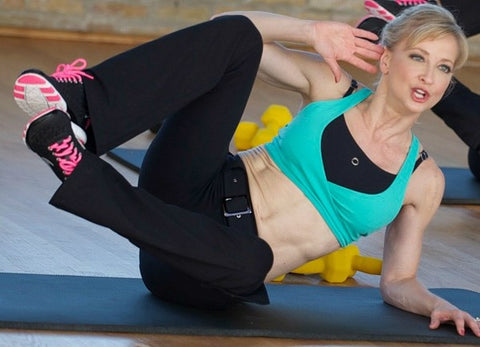Banana Raspberry Smoothie with Whey Protein
by Angie Miller

Smoothies are like ice cream, they taste great, go down easy, and after a workout there’s nothing that cools you off more. Unlike ice cream, however, smoothies are low in calories, high in protein, and they’re a great post-exercise meal replacement.
What's the best smoothie after exercise?
How about a Banana Raspberry Smoothie with Whey Protein? Full of essential nutrients, this smoothie is sweet, pink, and powerful. Not to mention, it’s a great way to help you recover after a tough workout and it’s quick and easy to make.
When it comes to smoothies, it’s safe to say that I’m experimental. I have never been one to follow recipes, and I love to see what I can come up with by mixing some of my favorite ingredients. I’m sharing this smoothie with you because it’s not only my favorite, it passed the ultimate test when I discovered that my husband and daughters enjoyed it as much as me. Having tasted some of my not so famous creations, they were as excited as I was when I came up with a smoothie that has all the health benefits, but still satisfies our sweet tooth. Check out my recipe and let me know what you think:
Banana Raspberry Smoothie with Whey Protein
- 1 cup of ice cubes
- ½ cup unsweetened vanilla almond milk
- ¾ cup fresh raspberries
- 1 large banana
- 1 to 2 scoops of whey protein powder
- Optional: ½ tsp. of honey or agave syrup
Here’s a picture of the ingredients I use:

Disclaimer: Please note that I’m not sponsored by these brands, nor am I promoting them for any purposes. I recommend that you use brands that fit your budget, needs, and taste buds.
Why drink a smoothie after a workout?
While power bars are quick and easy to grab, liquid replacement drinks, aka smoothies, come with added benefits. They pack a powerful punch after exercise, and they give your body what it needs, when it needs it the most. I cover post exercise meal replacement in my Collage Video blog, titled, “What’s the Best Way to Refuel After Exercise?”
Here are a few highlights to give you a refresher:
|
How soon after exercise should we be eating a post-workout meal? There is a window of opportunity, or “metabolic window,” that lasts approximately 60 to 90 minutes immediately following exercise, especially intense training. During this time, the body is most receptive to nutrient uptake and you have the best chance of reducing muscle damage. This window also allows you to maximize the muscle and strength gains from your workout. Should the post-exercise meal be solid foods or a liquid meal replacement? The moment you cease exercise the window of opportunity opens and from that time on the benefits begin to decrease. Because solid food can take approximately 2 to 3 hours to digest, it is generally not a recommended option as the window is closed by the time it’s digested. Although nutrition bars can be effective before and after exercise, liquid is generally recommended because of how quickly it is absorbed and nutrients are delivered to the muscles. How important is post-exercise nutrition? For most recreational exercisers post-workout feedings and snacks are not critical, but they can increase the potential benefits you receive from your workout, help you to prevent injury, fight fatigue, and avoid the stress of overtraining. For more information, here’s a link to the blog: |
Cheers to summer smoothies and lots of sunshine!
Best in Health~
Angie
Angie Miller, M.S., is a fitness educator, university instructor, and Licensed Professional Counselor who blends her skills and expertise to empower individuals, mentally and physically, and provide them the tools they need to succeed. A veteran group exercise instructor and personal trainer, Angie is the star of acclaimed exercise DVD’s, including the Bedroom Body™ workout. Her passion for progressive education brought her to Northern Illinois University, where she teaches in the Dept. of Kinesiology & Physical Education. Outside of the university, she presents at fitness conventions worldwide and leads industry trainings as an AFAA Certification Specialist and Kettlebell Concepts Master Instructor. Angie writes for fitness journals and digital communities, and blogs for Collage Video. Connect with Angie at: http://www.angiemillerfitness














